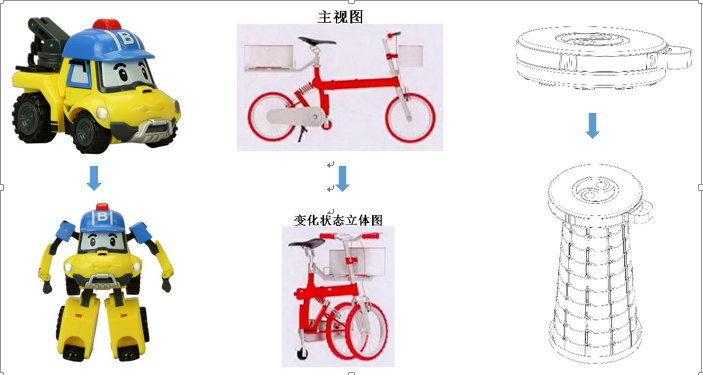- Home
- About Us
- Professionals
- Professionals
- Professionals

- Services
- Services
- Practice Areas
- Information Security

- News
- Database
- Database
- References
- Foundin Cases
- Related Websites

- Contact
How to Protect a Product Having Designs of Variable States in China?
Written by: Haoyu ZHOU (Elliot)
Products having variable states are increasingly popular. Designers around the world are fascinated with the idea of variable-state products. Toys, furniture, vehicle and apparel, just name a few, are all possibly designed into variable-state products, as shown below.
The question is how to protect a product having designs of variable states in a Chinese design patent?

Some applicants like to file a design patent application comprising a product having Variable State A and Variable State B, and they believe this would perfectly cover both designs. However, is this patent really enforceable against a product which was made to containing just State A but not State B? The answer is NO. Because the scope of this design patent was limited to a product containing both variable states, so there is no infringement if the competitor’s product only contains one of the states.
Other applicants like to file a design patent application comprising a product having Variable State A, while put State B as a reference drawing, and they believe this would cover both designs. But the question is, would this patent be enforceable against a product which was made to containing State B only but not State A? The answer is unfortunately NO. Because this patent only claimed a State A while State B was only shown as a reference drawing, the product having State B only is not claimed at all by this design patent.
In view of the above, the best mode to fully protect a variable-state product is to actually file three design applications.
l The first design application is directed to a Product with State A.
l The second design application is directed to a Product with State B.
l The third design application is directed to a variable-state product comprising both Variable State A and Variable State B. Six views of both Variable State A and Variable State B must be provided in this application.
Through this filing strategy, no matter the competitor makes a product comprising State A only, or a product comprising State B only, or makes a variable product convertible between State A and State B, they will always fall within the scope of one or other of the design patents.
In addition, if the designs of State A and State B are somehow similar, they may even be combined and pursued in a multiple-design application, as a cost-saving measure.
Of course, the actual situation could be more complicated, because Variable State A alone or Variable State B alone may not be patentable. For example, let’s assume Variable State A is not patentable for a lack of novelty, while Variable State B is patentable. In that case, the best mode for a full coverage of the designs will be to file two design applications.
l The first design application is directed to a Product with State B.
l The second design application is directed to a variable-state product comprising both Variable State A and Variable State B. Six views of both Variable State A and Variable State B must be provided.
Chinese design practice is undergoing a huge change recently. With the introduction of partial designs and increase of design patent term from 10 to 15 years, from 1st of June of 2021, Chinese design patents are becoming more enforceable and valuable. Some IP practitioners even predict that design patents will probably become a new battlefield for companies to compete in China in the next few years. This paper discusses the best way to protect designs of variable-state products, and give some advices on the pros and cons, so companies can adjust their filing strategies accordingly for their Chinese design applications.
If you have any questions about the Chinese patent and design practice, please feel free to contact Mr. Elliot ZHOU at patent@foundin.cn.

 adm
adm

